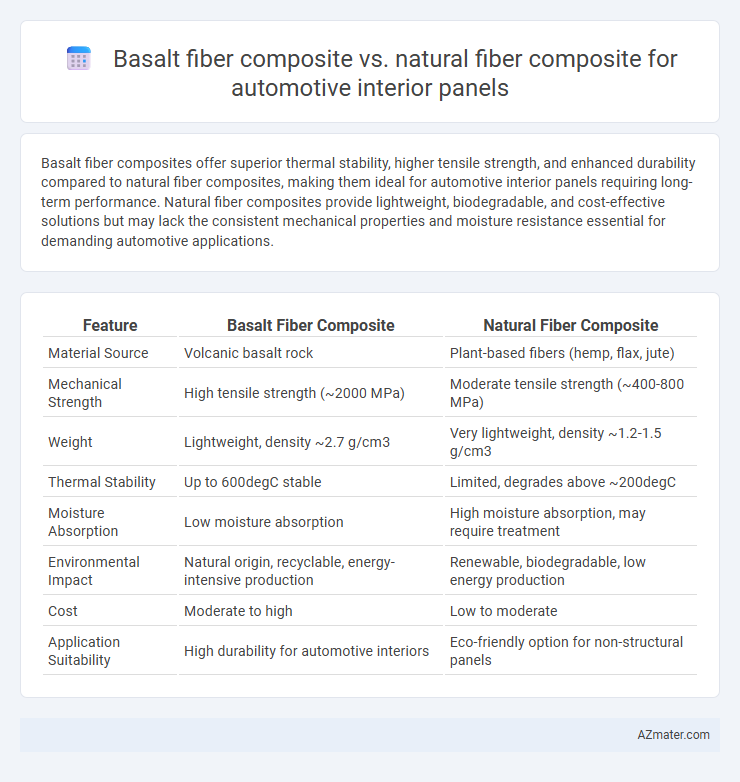Basalt fiber composites offer superior thermal stability, higher tensile strength, and enhanced durability compared to natural fiber composites, making them ideal for automotive interior panels requiring long-term performance. Natural fiber composites provide lightweight, biodegradable, and cost-effective solutions but may lack the consistent mechanical properties and moisture resistance essential for demanding automotive applications.
Table of Comparison
| Feature | Basalt Fiber Composite | Natural Fiber Composite |
|---|---|---|
| Material Source | Volcanic basalt rock | Plant-based fibers (hemp, flax, jute) |
| Mechanical Strength | High tensile strength (~2000 MPa) | Moderate tensile strength (~400-800 MPa) |
| Weight | Lightweight, density ~2.7 g/cm3 | Very lightweight, density ~1.2-1.5 g/cm3 |
| Thermal Stability | Up to 600degC stable | Limited, degrades above ~200degC |
| Moisture Absorption | Low moisture absorption | High moisture absorption, may require treatment |
| Environmental Impact | Natural origin, recyclable, energy-intensive production | Renewable, biodegradable, low energy production |
| Cost | Moderate to high | Low to moderate |
| Application Suitability | High durability for automotive interiors | Eco-friendly option for non-structural panels |
Introduction to Automotive Interior Panel Materials
Automotive interior panels increasingly utilize advanced composite materials to enhance durability and lightweight properties. Basalt fiber composites offer superior thermal resistance, high tensile strength, and excellent vibration damping, making them ideal for demanding automotive environments. Natural fiber composites provide eco-friendly advantages with biodegradability and low density but often require treatment to improve mechanical performance and moisture resistance for interior panel applications.
Overview of Basalt Fiber Composites
Basalt fiber composites offer superior mechanical strength, thermal stability, and resistance to corrosion compared to natural fiber composites, making them highly suitable for automotive interior panels requiring durability and safety. Derived from volcanic basalt rocks, these composites provide enhanced fire resistance and lower moisture absorption, improving the longevity and performance of car interiors. Their eco-friendly production processes and recyclability also position basalt fiber composites as a sustainable alternative in the automotive industry.
Overview of Natural Fiber Composites
Natural fiber composites for automotive interior panels utilize fibers such as flax, hemp, jute, and kenaf combined with polymers like polypropylene or epoxy, offering lightweight and eco-friendly alternatives to traditional materials. These composites exhibit favorable mechanical properties, good thermal insulation, and enhanced recyclability, contributing to reduced vehicle weight and carbon footprint. Natural fiber composites also provide cost-effectiveness and improved vibration damping, making them suitable for sustainable automotive design.
Mechanical Properties Comparison
Basalt fiber composites offer superior tensile strength and impact resistance compared to natural fiber composites, making them better suited for automotive interior panels requiring durability and safety. Their higher modulus of elasticity contributes to enhanced stiffness and dimensional stability under mechanical stress. While natural fiber composites provide lightweight and eco-friendly benefits, basalt fiber composites outperform in mechanical properties crucial for long-lasting, high-performance automotive applications.
Thermal Stability and Fire Resistance
Basalt fiber composites exhibit superior thermal stability and fire resistance compared to natural fiber composites, withstanding temperatures up to 600degC without significant degradation. Natural fiber composites, typically derived from hemp, flax, or jute, tend to have lower thermal resistance and can char or ignite at temperatures around 200-300degC, posing limitations for automotive interior panel applications. This makes basalt fiber composites a more durable and safer choice for high-temperature environments in automotive interiors.
Environmental Impact and Sustainability
Basalt fiber composites offer superior environmental benefits over natural fiber composites for automotive interior panels due to their higher durability and recyclability, which extend product lifecycle and reduce waste. While natural fiber composites are biodegradable and sourced from renewable resources, their shorter lifespan and susceptibility to moisture can lead to increased replacement frequency and energy use in manufacturing. The use of basalt fibers, derived from abundant volcanic rock with minimal chemical processing, supports sustainability goals through lower carbon emissions and enhanced material performance in automotive applications.
Weight and Design Flexibility
Basalt fiber composites offer higher strength-to-weight ratios compared to natural fiber composites, making them ideal for lightweight automotive interior panels that enhance fuel efficiency. Basalt fibers provide greater design flexibility due to their superior thermal stability and compatibility with various resin systems, enabling complex shapes and durable finishes. In contrast, natural fiber composites, while lighter, often face limitations in moisture resistance and mechanical properties, restricting design versatility and long-term performance in automotive interiors.
Cost Analysis and Manufacturing Considerations
Basalt fiber composites offer higher material costs compared to natural fiber composites but provide superior mechanical properties and thermal resistance, making them suitable for automotive interior panels requiring durability and longevity. Manufacturing basalt composites typically involves higher energy consumption and specialized processing techniques, while natural fiber composites benefit from lower raw material costs and easier processing with conventional equipment, contributing to overall cost-effectiveness. The trade-off between upfront material and processing costs versus performance and lifecycle benefits is crucial in selecting the appropriate composite for automotive interior applications.
Durability and Aging Performance
Basalt fiber composites exhibit superior durability and aging performance compared to natural fiber composites for automotive interior panels due to their high thermal stability, resistance to moisture absorption, and excellent mechanical strength retention over time. Natural fiber composites tend to degrade faster under UV exposure and humidity, leading to reduced structural integrity and increased susceptibility to microbial attack. The enhanced longevity and stable mechanical properties of basalt fiber composites make them a preferred choice for automotive applications requiring long-term reliability and minimal maintenance.
Future Trends and Industry Applications
Basalt fiber composites are gaining traction in automotive interior panels due to their superior thermal stability, mechanical strength, and environmental resistance compared to natural fiber composites, enabling enhanced durability and safety. The automotive industry is increasingly adopting basalt composites for lightweight, high-performance interiors that meet stringent regulatory standards and contribute to overall vehicle weight reduction, improving fuel efficiency. Future trends indicate a rising integration of basalt fibers with recycled materials and advanced manufacturing techniques, fostering sustainable and cost-effective solutions that align with the shift toward greener automotive designs.

Infographic: Basalt fiber composite vs Natural fiber composite for Automotive interior panel
 azmater.com
azmater.com